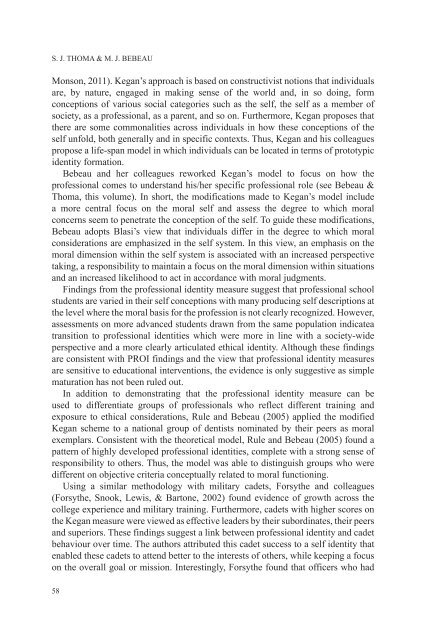Handbook of moral motivation: Theories, models ... - Sense Publishers
Handbook of moral motivation: Theories, models ... - Sense Publishers
Handbook of moral motivation: Theories, models ... - Sense Publishers
- No tags were found...
Create successful ePaper yourself
Turn your PDF publications into a flip-book with our unique Google optimized e-Paper software.
S. J. THOMA & M. J. BEBEAUMonson, 2011). Kegan’s approach is based on constructivist notions that individualsare, by nature, engaged in making sense <strong>of</strong> the world and, in so doing, formconceptions <strong>of</strong> various social categories such as the self, the self as a member <strong>of</strong>society, as a pr<strong>of</strong>essional, as a parent, and so on. Furthermore, Kegan proposes thatthere are some commonalities across individuals in how these conceptions <strong>of</strong> theself unfold, both generally and in specific contexts. Thus, Kegan and his colleaguespropose a life-span model in which individuals can be located in terms <strong>of</strong> prototypicidentity formation.Bebeau and her colleagues reworked Kegan’s model to focus on how thepr<strong>of</strong>essional comes to understand his/her specific pr<strong>of</strong>essional role (see Bebeau &Thoma, this volume). In short, the modifications made to Kegan’s model includea more central focus on the <strong>moral</strong> self and assess the degree to which <strong>moral</strong>concerns seem to penetrate the conception <strong>of</strong> the self. To guide these modifications,Bebeau adopts Blasi’s view that individuals differ in the degree to which <strong>moral</strong>considerations are emphasized in the self system. In this view, an emphasis on the<strong>moral</strong> dimension within the self system is associated with an increased perspectivetaking, a responsibility to maintain a focus on the <strong>moral</strong> dimension within situationsand an increased likelihood to act in accordance with <strong>moral</strong> judgment s.Findings from the pr<strong>of</strong>essional identity measure suggest that pr<strong>of</strong>essional schoolstudents are varied in their self conceptions with many producing self descriptions atthe level where the <strong>moral</strong> basis for the pr<strong>of</strong>ession is not clearly recognized. However,assessments on more advanced students drawn from the same population indicateatransition to pr<strong>of</strong>essional identities which were more in line with a society-wideperspective and a more clearly articulated ethical identity. Although these findingsare consistent with PROI findings and the view that pr<strong>of</strong>essional identity measuresare sensitive to educational interventions, the evidence is only suggestive as simplematuration has not been ruled out.In addition to demonstrating that the pr<strong>of</strong>essional identity measure can beused to differentiate groups <strong>of</strong> pr<strong>of</strong>essionals who reflect different training andexposure to ethical considerations, Rule and Bebeau (2005) applied the modifiedKegan scheme to a national group <strong>of</strong> dentists nominated by their peers as <strong>moral</strong>exemplars. Consistent with the theoretical model, Rule and Bebeau (2005) found apattern <strong>of</strong> highly developed pr<strong>of</strong>essional identities, complete with a strong sense <strong>of</strong>responsibility to others. Thus, the model was able to distinguish groups who weredifferent on objective criteria conceptually related to <strong>moral</strong> functioning.Using a similar methodology with military cadets, Forsythe and colleagues(Forsythe, Snook, Lewis, & Bartone, 2002) found evidence <strong>of</strong> growth across thecollege experience and military training. Furthermore, cadets with higher scores onthe Kegan measure were viewed as effective leaders by their subordinates, their peersand superiors. These findings suggest a link between pr<strong>of</strong>essional identity and cadetbehaviour over time. The authors attributed this cadet success to a self identity thatenabled these cadets to attend better to the interests <strong>of</strong> others, while keeping a focuson the overall goal or mission. Interestingly, Forsythe found that <strong>of</strong>ficers who had58














